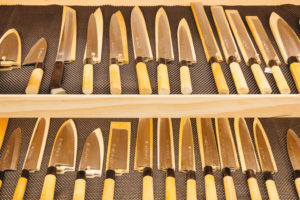Curious why Japanese kitchen knives are regarded as the finest culinary tools? Learn about the different types of knives used in Japanese cuisine and how they are made so you can find the perfect one for you! Bonus tips: how to care for and maintain the knives and where to buy them.
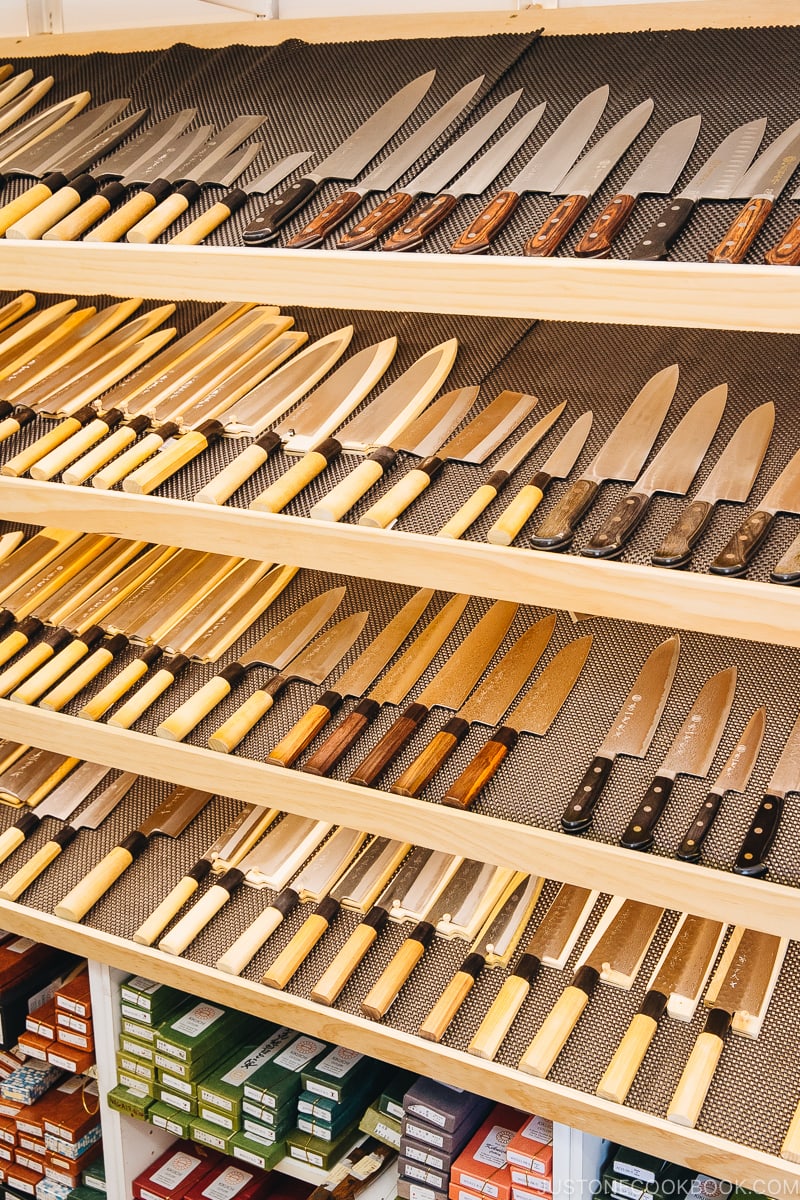
Japanese knives (Hōchō 包丁) have a cult following by culinary professionals and passionate cooks around the world. With its world-renowned reputation for outstanding and artisanal craftsmanship, you may dream of owning one or two yourselves!
Whether you cook Japanese cuisine or not, a beautifully crafted knife can make all the difference in your chopping skills and the final dish! But with all the varieties, brands, and price ranges, finding the knife that fits you can seem daunting.
Here’s a guide to kick your interest in Japanese knives to demystify the centuries-old legacy and romance surrounding Japanese knives. After the end of the article, we hope you’ll find a knife (or two!) that best fits you!
The photos are from the Perfect Edge Cutlery, a knife shop based in San Mateo, California. Perfect Edge Cutlery provides professional chefs and home cooks with the best knife service. They carry a huge assortment of Nami’s favorite Kikuichi knives!
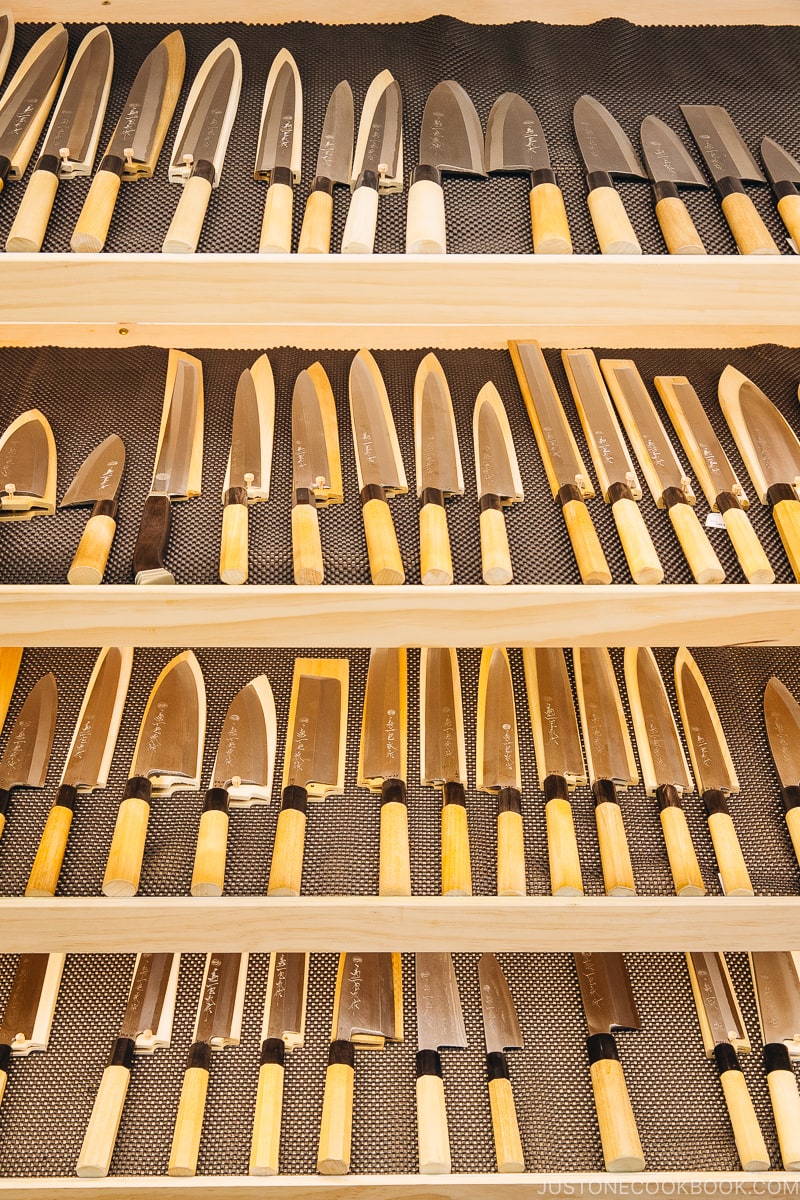
The History of Japanese Knives
The earliest artifacts of Japanese knives can be traced back to the Nara Era (710-794), displayed at the Shosoin (正倉院; the Imperial Treasure House) in Nara prefecture. The blade and handles were long and narrow, 40cm in length and 2cm in width, with a slight curve. It is said that the aristocracy used this type of knife for religious ceremonies. Called Hocho-shiki (包丁式; literally “knife ceremony”), the knives were used to break down carp and cranes to the tune of music.
Unlike swords, considered family heirlooms and passed down generations, knives were everyday tools that would disintegrate over time with daily use. Therefore, while there are no surviving artifacts of knives, there are plenty of written records, scroll paintings, and drawings of knives.
Evolution Beyond Samurai Swords
When we speak of Japanese knives, it cannot be forgotten that the technological development of Japanese swords greatly influenced them. These swords, called Katana (刀), were reserved only for the Samurai (武士), a military nobility serving a feudal lord. The creation of this class, followed by the demand for swords, greatly boosted the production and development of blade technology.
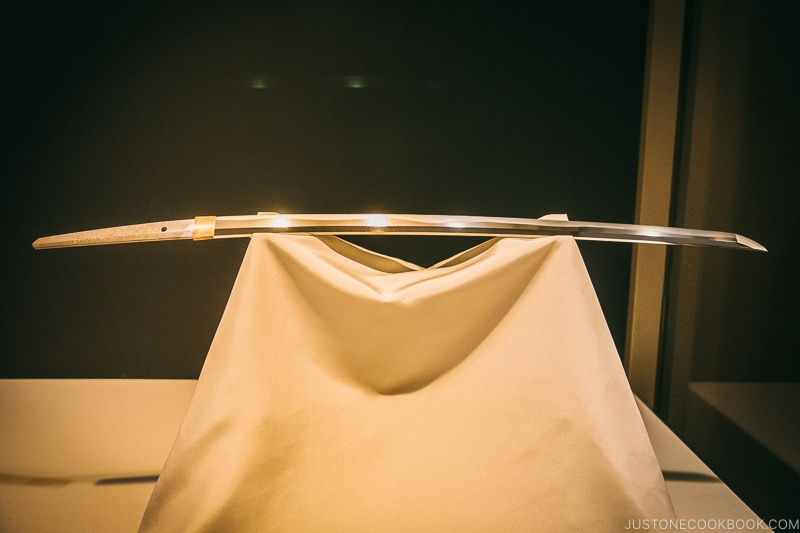
During the tumulus feudal unrest of the Sengoku Era (1454-1573), the central sword production regions were in Okayama, Kanagawa, Kyoto, Nara, and Gifu prefectures. Not coincidentally, the feudal warlords were the strongest in these five regions.
However, the demand decreased during the Edo Period (1603-1868), an era marked by relative peace and isolationism from the outside world. With the lack of warfare and battles (and, therefore, civilians being able to live a non-combative lifestyle), demand for kitchen knives and farming tools such as axes, saws, and hatchets increased.
The creation and possession of weapons, including Katana, were banned entirely during the Meiji Restoration of 1868. Called the Sword Abolishment Edict (廃刀令), violators walking around with their swords would have them confiscated by the police. This law, in turn, created unemployment for the sword-smiths and artisans.
Many of these artisans switched from producing swords to kitchen and household blades to withstand the change of time. Some started creating superior products by applying their centuries-old knowledge of sword-making. A well-known example is Sakai (堺) in Osaka. The area of Sakai had been producing blades from the Heian Era (794–1185) and was famous for its guns, swords, and tobacco-cutting knives from the Muromachi Era (1336-1573). To this day, the Sakai area still produces high-quality Japanese knives, and chefs worldwide highly respect their products.
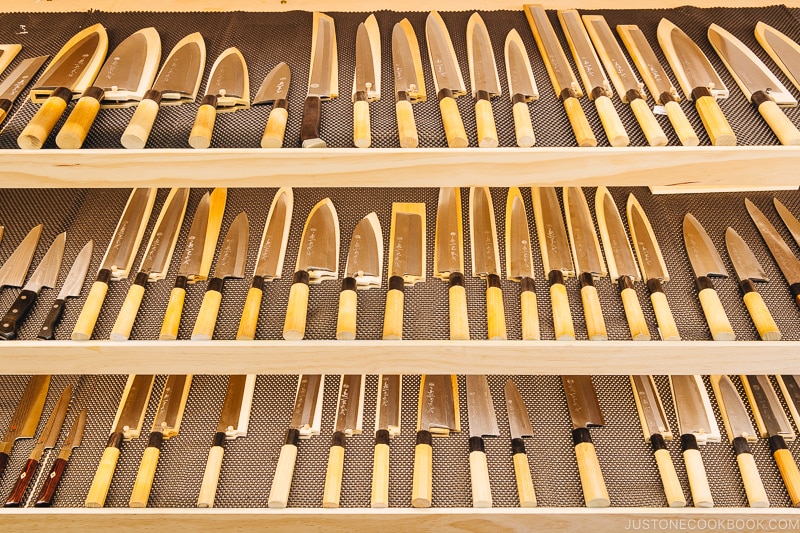
Difference between Japanese and Western Knives
Material
Japanese knives are traditionally made with a type of carbon steel called Hagane (鋼). The blades are forged in multiple layers, with a brittle carbon steel core and a softer iron steel outer layer. This combination produces an extremely sharp edge, similar to a Japanese sword. Hagane is not as hard as stainless steel and can chip from tough fish bones and rust from residual bits of food or droplets of water on the blade. Thus, professional chefs rigorously maintain their knives to avoid dullness and rust.
Western and Japanese knives for household use are made of stainless steel, which is much easier to maintain and durable. They are rust and corrosion-resistant and suitable for those who like to forgo the frequent maintenance of a Hagane knife. Note that stainless steel knives are not inferior to Hagane; they have the perks of retaining their sharp edge and are easier to sharpen.
Bevel
Traditional Japanese knives are characterized by their single-bevel blade, a sharpened edge on one side of the blade surface and the other completely straight. This edge makes it ideal for precise slicing motions; picture the Samurai action scene where he cuts down his foes in an up-to-down diagonal motion. When sharpening the blade, you sharpen just one side. However, single-beveled knives are made for right-handed users, so lefties need specialty leftie knives, which can be expensive.
Western knives, on the other hand, are double-beveled. Most double-beveled blades have a V-shaped blade edge. While not made for high-precision cuts, it’s much easier to sharpen.
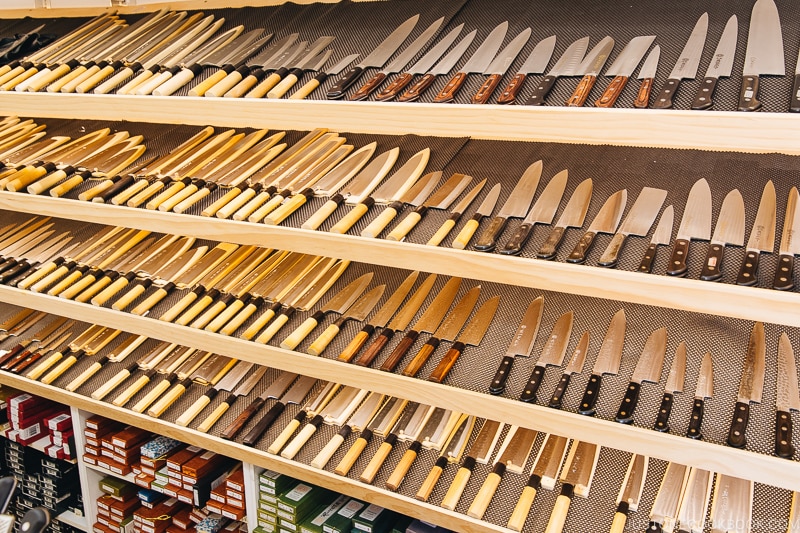
Varieties of Japanese Knives
The realm of Japanese knives is expansive, but not to worry! The everyday Japanese cook will have one or two basic knives, whereas the specific-purpose knives are primarily for chefs and professionals. But for those curious, here’s a list of Japanese knives you may encounter at a Japanese knife shop.
Note that there are regional varieties regarding knife craftsmanship, Kanto (eastern Japan, where Tokyo is located) and Kansai (central Japan, where Kyoto and Osaka are located) styles being the main ones.
The Basic Knives
1. Nakiri bocho (菜切り包丁)
For peeling, chopping, and slicing vegetables. The blade is thin, straight, and double-beveled. Kanto knives are rectangular, whereas Kansai knives are rounded at the tip. It has a blade length of 240-300mm. It’s easier and cheaper to sharpen than a Usuba.
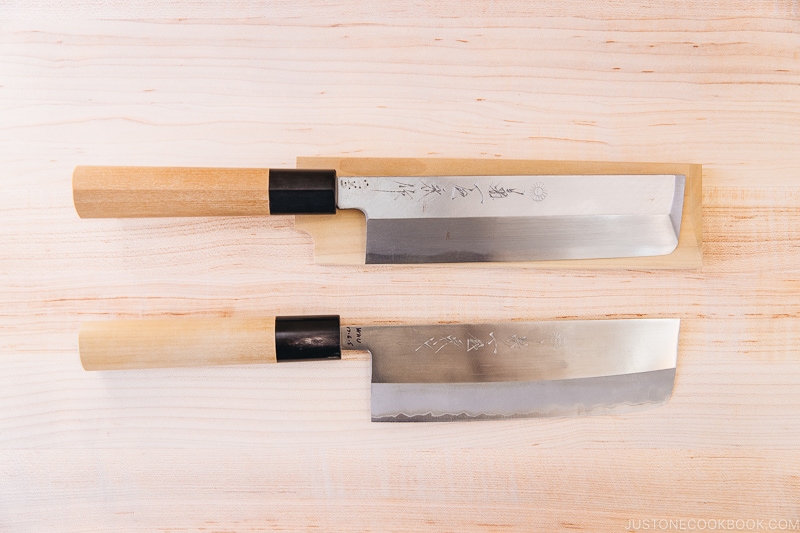
Usuba (above) and Nakiri (below) knives
2. Usuba bocho (薄刃包丁)
Similar to a Nakiri, but single-beveled. The thin blade makes it excellent for paper-thin slices and decorative cuts. Chefs prefer the Usuba over the Nakiri for its precision, but it’s a challenge for beginners to sharpen the delicate blade.
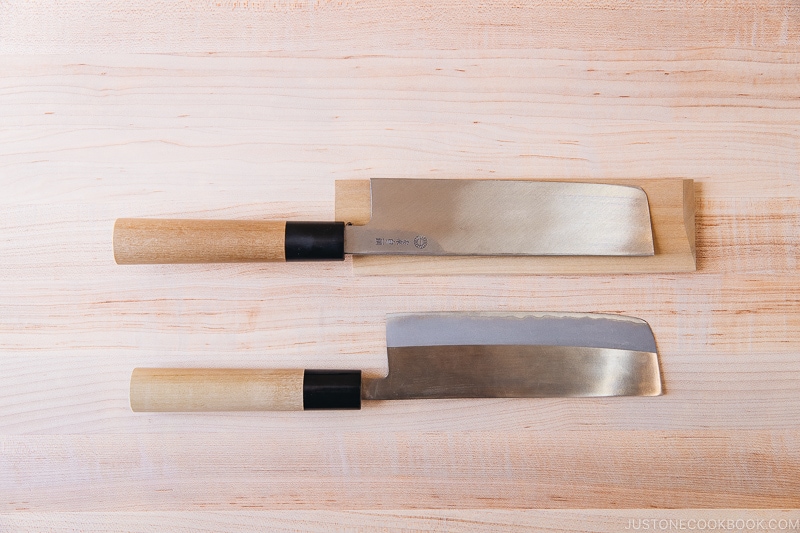
The other side of Usuba (above) and Nakiri (below) knives
3. Deba bocho (出刃包丁)
For gutting, descaling, and breaking down fish. It has a chunkier blade to withstand cutting thick fish bones. It comes in 3 sizes for different sizes of fish. Kodeba (子出刃) has a blade length of 90-120mm, Hondeba (本出刃) is a standard size around 210mm, Miokoshi Deba (身卸し出刃包丁) is 180-270mm in length.
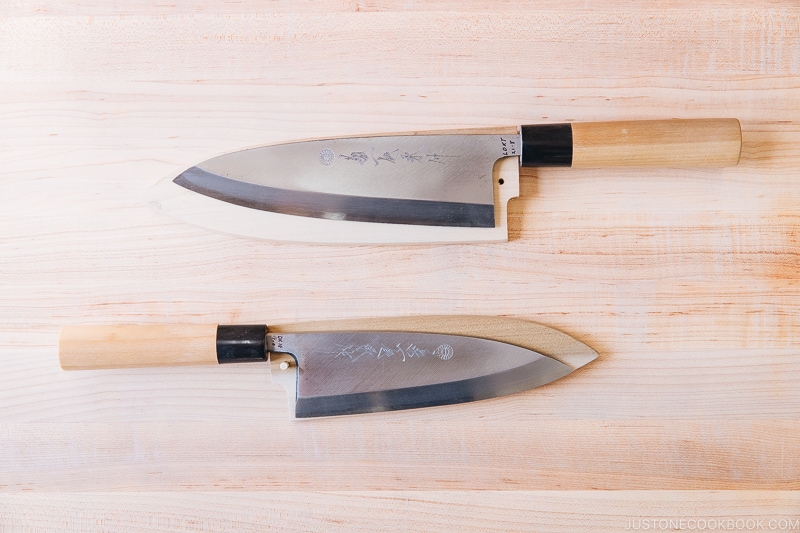
Hondeba (above) and Kodeba (bottom) knives
4. Santoku bocho (三徳包丁)
Literally, “three virtues,” it’s named from being an all-rounder for meat, fish, and vegetables. This versatile knife was created around the Meiji era when Western cuisine was popularized among the Japanese, and the distinction between Western and Japanese cuisine blurred. They’re excellent for chopping and long-cutting strokes. Nowadays, most Japanese families forgo the Deba and Usuba for one Santoku knife.
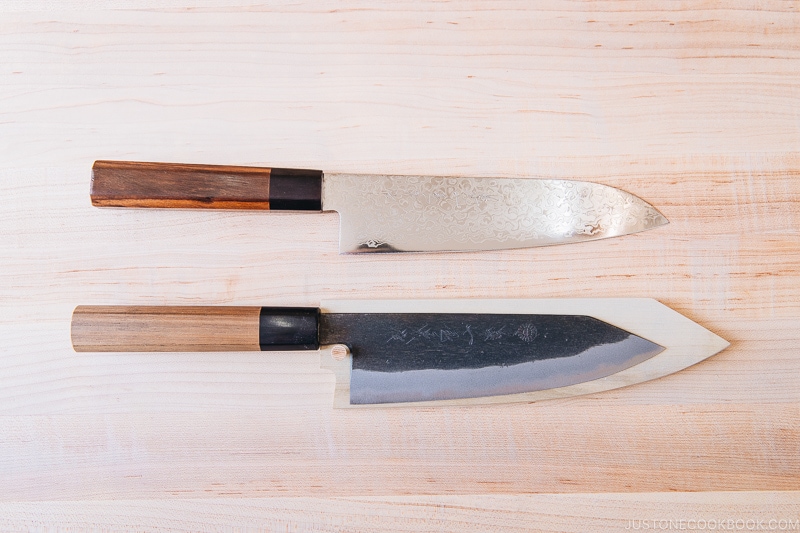
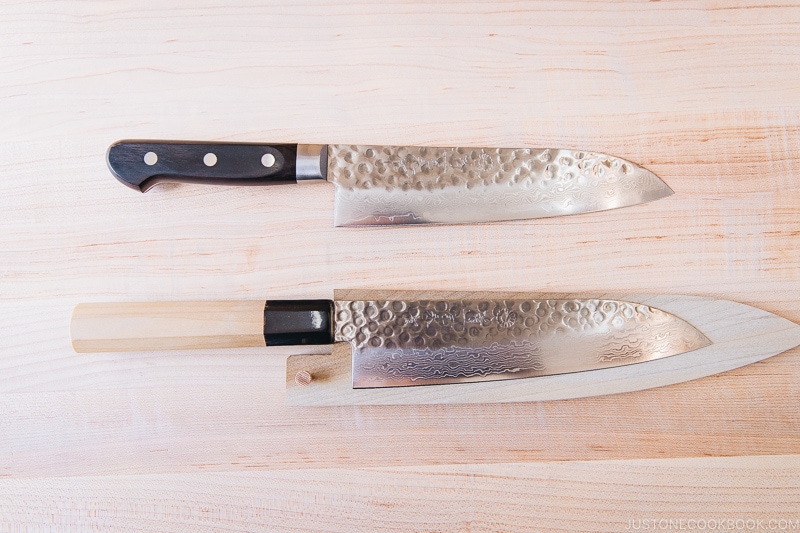
Santoku knives, the difference being the material, handle, and decorations on the blade
Specialty Knives
These knives are primarily owned and used by chefs in their respective fields. For example, a sushi chef will own several Sashimi knives but not a Menkiri knife.
5. Yanagiba bocho (柳刃包丁)
Literally a “willow blade,” this knife is for slicing blocks of raw fish for sashimi. It has a long, slim blade, is curved at the blade tip, and is used primarily in the Kansai region. Also generally referred to as Sashimi-bocho (刺身包丁; “sashimi knife”).
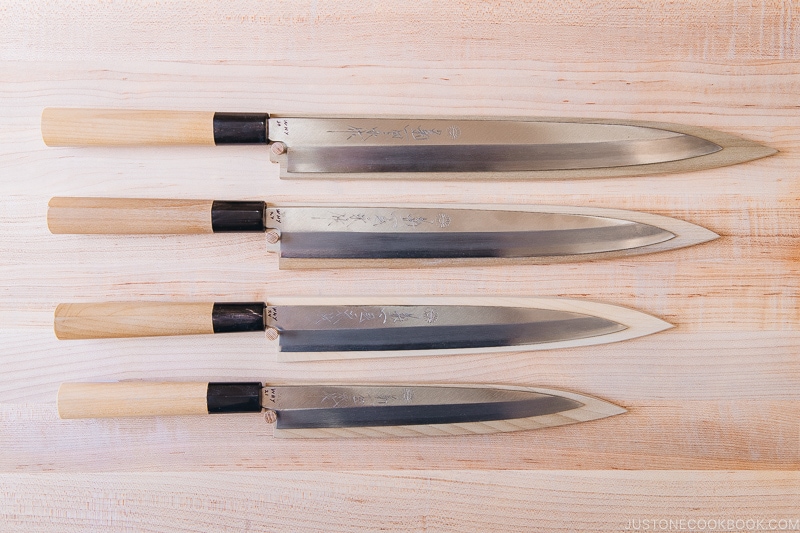
Different lengths of Yanagiba knives
6. Takohiki bocho (蛸引き包丁)
Also used for slicing sashimi, but rectangular. Used primarily in the Kanto region. Also generally referred to as Sashimi-bocho (刺身包丁; “sashimi knife”).
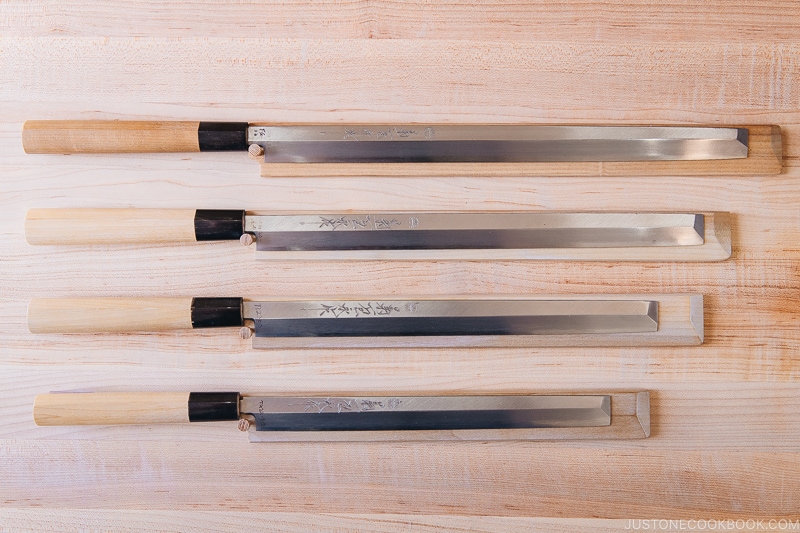
Different lengths of Takohiki knives
7. Fugu hiki (河豚引き)
Similar to a Yanagiba, but with a narrower and thinner blade. Explicitly used for slicing Fugu (pufferfish).
8. Honekiri bocho (骨切り包丁) or Hamogiri (鱧切り)
Use to cut the long and sharp bones of pike conger and fat greenling without cutting through to the skin. It’s heavy and straight-edged for cutting precisely and crushing the bones.
9. Menkiri bocho (麺切り包丁)
For cutting udon and soba noodles. Heavy with a straight edge, it looks like a cleaver with the blade extending to the handle.
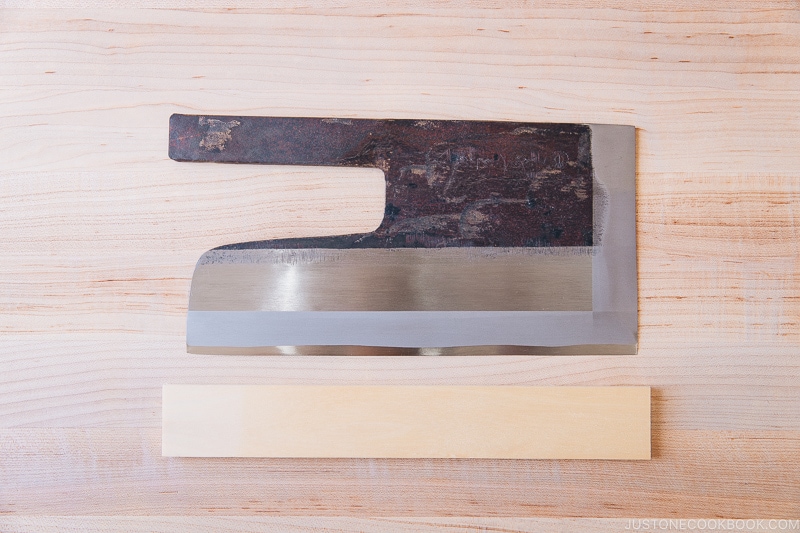
A Menkiri knife
10. Unagisaki bocho (鰻裂き庖丁)
For cutting through the slippery Unagi (freshwater eel), a delicacy eaten during the humid months. There are five different styles of Unagisaki knives based on the region and the preparation styles. They are Edo saki (江戸裂き), Nagoya saki (名古屋裂き) Osaka saki (大阪裂き), Kyo saki (京裂き), and Kyushu saki (九州裂き). The sharp tip is used to pierce through the thick skin, then used to filet the long fish.
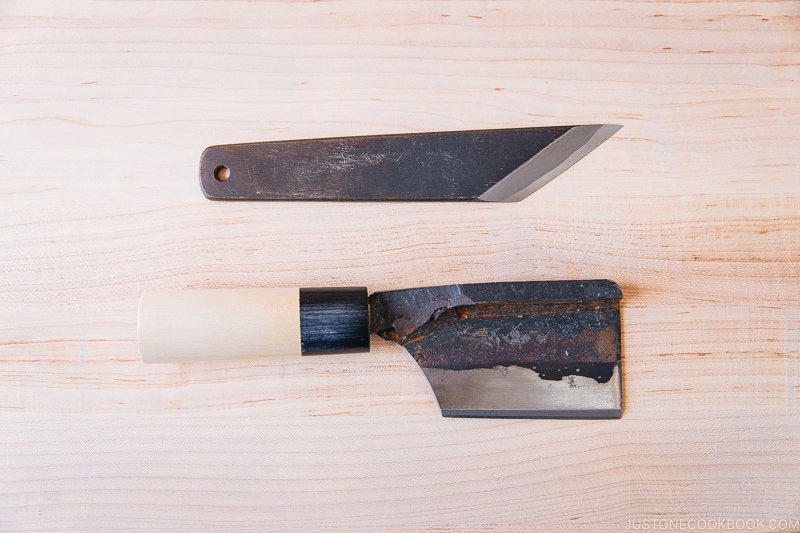
Osaka saki (above) and Kyo saki (below)
Fun Fact: in Kanto, the eel is cut on its back, whereas in Kansai, it is cut on its stomach. In Nagoya (squeezed between Kanto and Kansai), unagi may be cut from its back or stomach. The Kanto method of eel preparation is steaming and grilling, whereas in Kansai, it is grilled.
Japan-Born Knives (but not used in Washoku/Japanese Cooking)
There are also specialty Japan-born knives that have adapted to the Westernization/globalization of cooking. Thus, they are not considered traditional per se but beloved by chefs and home cooks.
11. Gyuto – Chef’s Knife (牛刀)
Like the Western chef’s knife, Gyuto (literally “cow knife”) is an all-purpose knife. These knives range from 210-270mm long, with a tall heel, curved blade, and pointed tip. The knife is excellent for piercing and rocking motions, although often slightly more expensive than a Santoku.
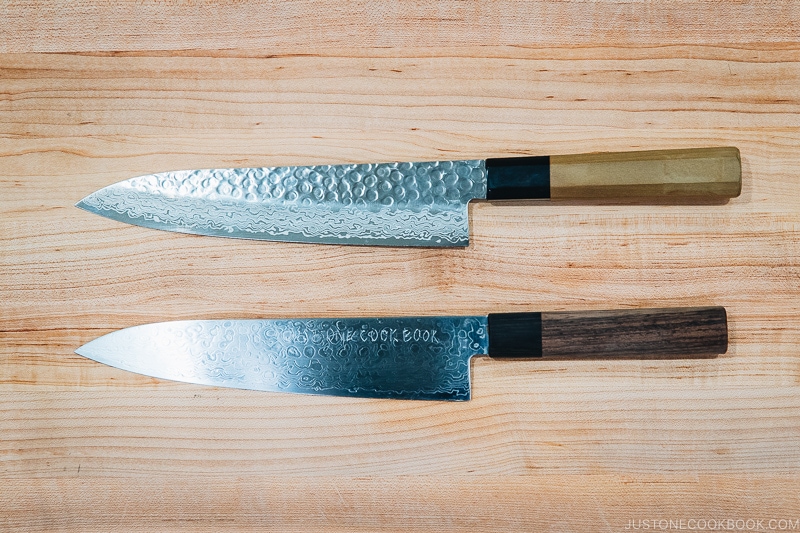
Gyuto – Chef’s Knife
You can see Gyuto and Santoku are pretty similar, but when placed next to each other, Sankotu has a shorter tip and is more angled.
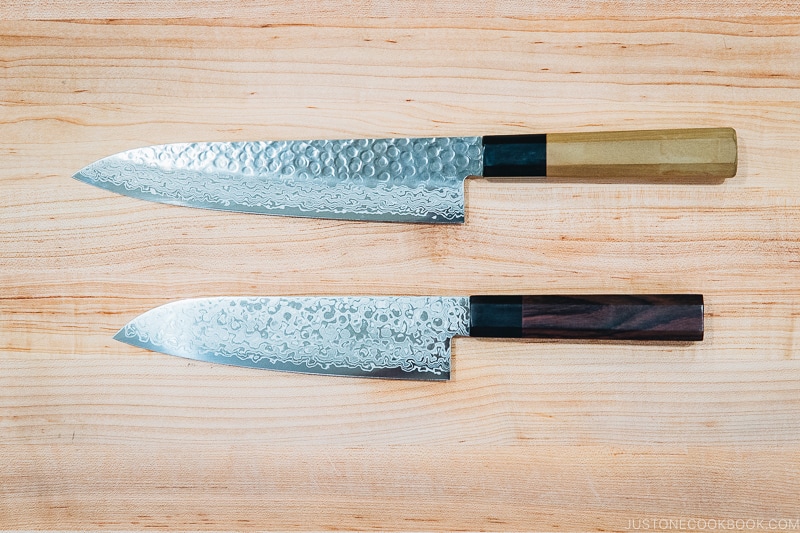
Gyuto vs. Santoku – check out the front of the knives
12. Garasuki (ガラスキ) and Honesuki (骨すき)
The Japanese version of a boning knife is perfect for breaking down chicken and red meat. Garasuki and Honesuki are characterized by their triangular blade, sharp tip, and tough blade. Garasuki is larger and heftier than a Honesuki. While the knives are not made for cutting through bones, the nifty blade is best for maneuvering around tight spaces.
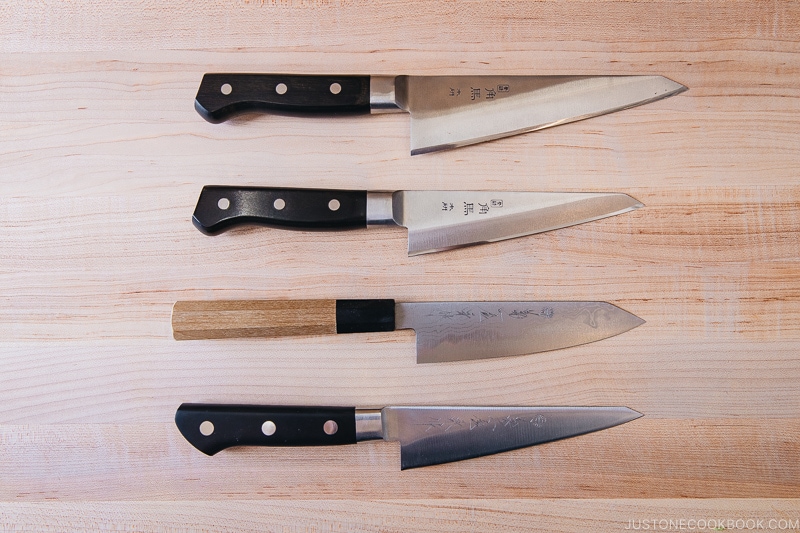
Garasuki and Honesuki
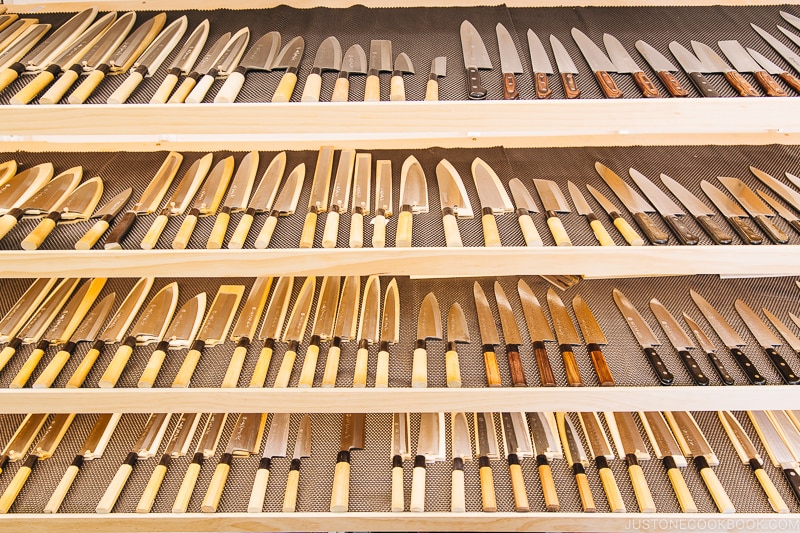
What Kind of Knife Should I Buy?
Now that you’ve learned about the different types and are interested in investing in a Japanese knife, what should you get?
First, there is no such thing as “the best Japanese knives.” Many Just One Cookbook readers have asked Nami for her recommendation, and she recommends Kikuichi Cutlery brand (often featured in her videos).
Outside of Japan, you may encounter Japanese brands such as Miyabi, Shun, and Tojiro.
However, if you wish to purchase quality knives that fit your culinary skills and needs, I suggest researching beforehand to find the perfect one.
First, I cannot stress enough the importance of physically handling the knives yourself to understand the knife’s characteristics. Never buy knives online without trying them, regardless of the price, and avoid lists like “best-selling knives.” Try holding several different types and brands at a reputable knife shop. The knife shop may direct you to knives based on interest and price range. Ask if the shop has a carrot or onion to test the blade.
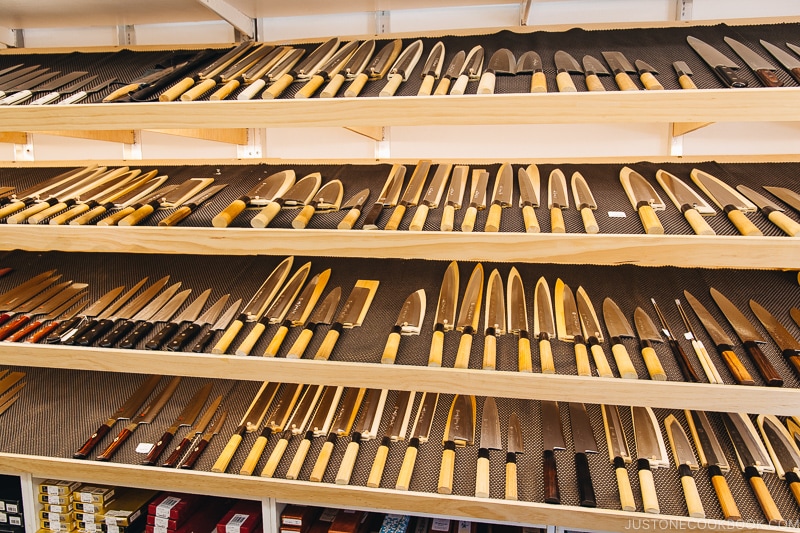
A Quick Guide to Choosing the Right Knife:
When browsing for knives at a shop, it may be helpful to ask yourself the following questions:
- Grip: How does the grip feel when you’re holding it? Is it too thick or thin that the tips of your fingers awkwardly bump into each other when gripping the handle or too big that your hands feel lost?
- Weight: Does the blade feel too heavy or too light? Assume that you may be holding the knife for 10-15 minutes. Will your hand and arm get tired from the weight? Or do you prefer a knife with some heaviness?
- Length: Is the blade too long or short? People with smaller hands should use knives with a smaller blade, for instance.
- Material: Do you prefer a blade made of Hagane or stainless steel? As mentioned above, Hagane requires frequent maintenance, whereas stainless steel holds its sharpness and is easier to care for.
- Craftsmanship: Overall, do you trust the craftsmanship? Cheaper blades are made in China and are mass-produced, whereas most Japan-made knives are forged by hand.
- Overall: Do you like the design and look of the knife? Would you want an engraving on the blade? While aesthetics alone will not alter your knife skills, you should pick one you like!
An anecdote: When I started culinary school in Tokyo, we were given Western and Japanese knives (Sakai knives from Osaka, for those curious). While the knives were of high quality, I found some difficult to use as the blades were massive, and the grip was uncomfortable in my small hands (for reference, I have short fingers and small palms).
When I started working in kitchens after graduating, I went to a knife shop and, after consulting with the shop owner, was recommended a 22cm stainless steel Santoku knife. Not only did I cut myself less often, but I was also much more comfortable wielding the blade and saw a significant improvement in my chopping skills. While I do not work in kitchens nowadays, I use this knife daily and am much happier with the experience overall.

How to Care and Maintain Your Knife
Following the investment of your knife (or knives), you should also seriously consider its maintenance. While this is understandably difficult for the everyday cook, taking great care of them is critically important for their lifespan. Sharpened knives will naturally dull with use and may rust depending on the material. While this may be a pain, treat your knives like musical instruments, which need fine-tuning and check-ups occasionally.
Never use a knife sharpener (the one that you drag the blade across). Not only does that whittle down the blade, but the friction can also cause strain. The majority of these knife sharpeners are made for double-bladed Western knives anyway and not made for Japanese knives.
The same applies to the honing steel/ceramic rods; this is only for Western-style knives. Contrary to popular belief, this does not sharpen a dull blade; it only aligns a bent-out edge. Thus, honing makes sense only if you have already sharpened the blade.
1. Maintaining Your Knife
There are a few things you could do to maintain your knives at home.
- Use a ceramic rod to align the blade — From time to time, slice downwards on both sides of the knife about ten times to “bend” the edge back (double bevel blades only). This will help with maintaining edge retention.
- Wipe your knives well after washing — Unless you wish for stubborn rust to overtake your blade, always wipe down your knives, including the handle, after hand washing. Also, in general, you should never wash any knife in the dishwasher. The hot water and harsh chemicals from the dish detergent will damage your knife. Store in a dry place.
- Use a proper surface to cut — Your chopping board can also affect your knife’s lifespan. Avoid fancy boards like granite, glass, or other hard surfaces that can chip away the blade, and use wood, plastic, or bamboo boards.
2. How to Test A Knife’s Sharpness
Depending on the frequency, you should sharpen your knives periodically. For home cooks, Perfect Edge Cutlery recommends sharpening every 4-6 months.
To check the sharpness of your knife, do the paper test: hold the corner of a sheet of paper with your other hand and lightly drag your knife across it. If the cut is smooth without dragging, your knife is sharp. Or you can try slicing a tomato: if you can cut through the skin and flesh without squashing the fruit, your knife is ready to go.
Remember that a dull knife is more dangerous than a sharp one; a sharp knife requires minimal effort to cut, whereas a dull knife needs pressure, resulting in a deeper (and more serious) incision than a clean (and often shallow) cut.
3. Sharpening your Knife
Option 1: Bring it to a reputable knife sharpening shop
Take your knives to a reputable knife shop to have them professionally sharpened and polished. This routine may be bothersome and adds up, but you will be satisfied knowing that your knives are returned beautifully razor-sharp.
Option 2: Sharpen it yourself
You don’t need fancy equipment and accessories to sharpen knives. You can buy a whetstone and learn how to sharpen yourself. There are online tutorials on YouTube, but for beginners, it could be somewhat nerve-wracking! If you have never done it, practice on a $5 knife and not your favorite $250 prized knife.
You could also look for a knife sharpening workshop or ask an expert friend or family. To sharpen, start with a 1000 gritstone. If you wish to fine-tune your blade, polish it with a higher grit stone above 4000 grit and coat it with Camilla oil for protection. It would be best to buy a rust eraser to remove rust and stubborn stains.
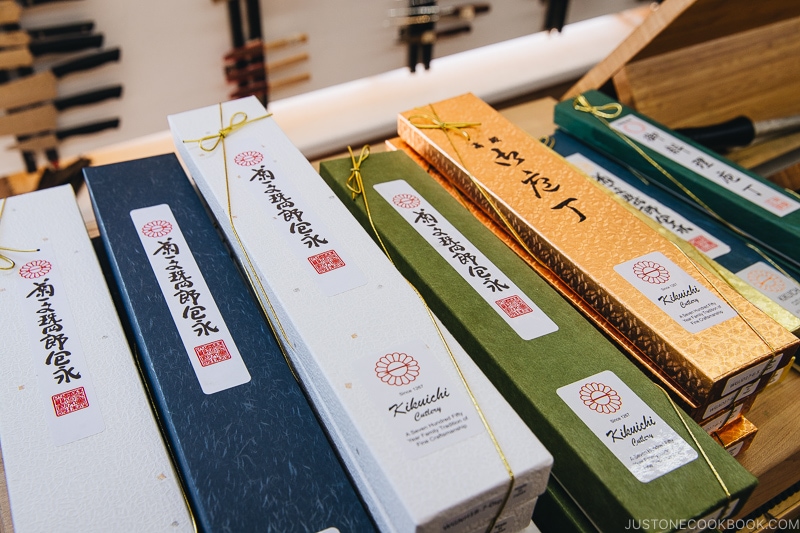
Where to Buy Japanese Knives
If you’re visiting Japan, check out Kappabashi (for everything kitchen and restaurant supplies related) in Tokyo, Sennichimae Doguyasuji (similar to Kappabashi) in Osaka, various department stores, or seek direct sellers of knife brands. I hope your journey to your knife is a rewarding adventure!
Perfect Edge Cutlery San Mateo
Lastly, if you are in the San Francisco Bay Area, check out Perfect Edge Cutlery in San Mateo. They are very knowledgeable with knives and carry an extensive collection of both Japanese and Western knives. Many of their customers are in the food industry, and if you have any knife questions, they probably have the answer.
Nami has purchased all her knives and sharpened them there as well. Thank you to Tara and the team at Perfect Edge Cutlery for kindly allowing us to take photos of their knives. Do check them out should you be in the area!
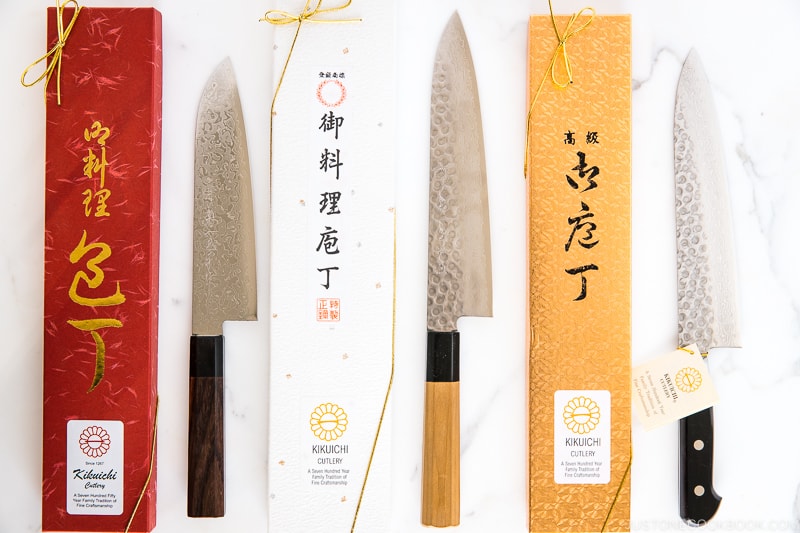
We’re also hosting a WORLDWIDE Kikuichi Knife Giveaway. Enter for your chance to win one of three beautiful Kikuichi knives!


